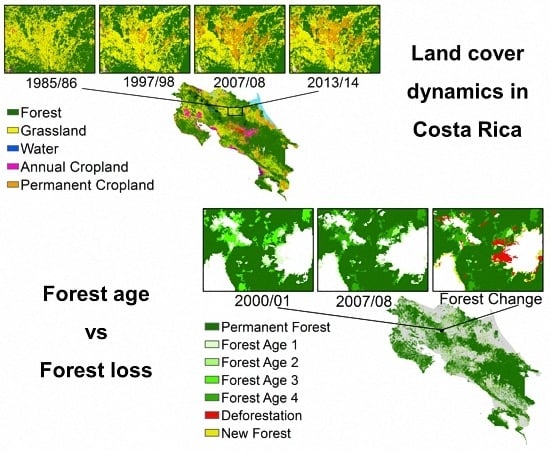An Operational Framework for Land Cover Classification in the Context of REDD+ Mechanisms. A Case Study from Costa Rica
Abstract
:1. Introduction
2. Materials and Methods
2.1. Historical Period
2.2. Data
2.3. Classification Scheme
2.4. Software
2.5. Imagery Pre-Processing
2.6. Predictor Variables
2.7. Image Classification
2.8. Post-Processing of the Classification
2.9. Validation
3. Results
3.1. Land Cover Classification
3.2. Land Cover Change Detection
4. Discussion
4.1. Land Cover Classification
4.2. Land Cover Change Detection
5. Conclusions
Acknowledgments
Author Contributions
Conflicts of Interest
References
- Angelsen, A.; McNeill, D. Evolution of REDD. In Analysing REDD+: Challenges and Choices; Angelsen, A., Brockhaus, M., Sunderlin, W.D., Verchot, L.V., Eds.; Center for International Forestry Research: Bogor Barat, Indonesia, 2012; pp. 31–51. [Google Scholar]
- Angelsen, A.; Brockhaus, M.; Sunderlin, W.D.; Verchot, L.V. Analysing REDD: Challenges and Choices; Center for International Forestry Research (CIFOR): Bogor, Indonesia, 2012. [Google Scholar]
- UNFCCC. Report of the Conference of the Parties on its Seventeenth Session; Decision 12/CP.17, Durban, 28 November to 11 December 2011; UNFCC: Bonn, Germany, 2011. [Google Scholar]
- UNFCCC. Methodological Guidance for Activities Relating to Reducing Emissions from Deforestation and Forest Degradation and the Role of Conservation, Sustainable Management of Forests and Enhancement of Forest Carbon Stocks in Developing Countries; Decision 4/CP.15, UN Doc FCCC/CP/2009/11/Add.1 (30 March 2010); UNFCCC: Bonn, Germany, 2010. [Google Scholar]
- De Sy, V.; Herold, M.; Achard, F.; Asner, G.P.; Held, A.; Kellndorfer, J.; Verbesselt, J. Synergies of multiple remote sensing data sources for REDD monitoring. Curr. Opin. Environ. Sustain. 2012, 4, 696–706. [Google Scholar] [CrossRef]
- Joseph, S.; Herold, M.; Sunderlin, W.D.; Verchot, L.V. REDD readiness: Early insights on monitoring, reporting and verification systems of project developers. Environ. Res. Lett. 2013, 8, 034038. [Google Scholar] [CrossRef]
- Korhonen-Kurki, K.; Brockhaus, M.; Duchelle, A.E.; Atmadja, S.; Thuy, P.T. Multiple levels and multiple challenges for REDD. In Analysing REDD 2012; Center for International Forestry Research (CIFOR): Bogor, Indonesia, 2012; Volume 91. [Google Scholar]
- UNFCCC. Cost of Implementing Methodologies and Monitoring Systems Relating to Estimates of Emissions from Deforestation and Forest Degradation, the Assessment of Carbon Stocks and Greenhouse Gas Emissions from Changes in Forest Cover, and the Enhancement of Forest Carbon Stocks; Technical Paper FCCC/TP/2009/1; UNFCCC: Bonn, Germany, 2009. [Google Scholar]
- Hansen, M.C.; Loveland, T.R. A review of large area monitoring of land cover change using Landsat data. Remote Sens. Environ. 2012, 122, 66–74. [Google Scholar] [CrossRef]
- GOFC-GOLD. A Sourcebook of Methods and Procedures for Monitoring and Reporting Anthropogenic Greenhouse Gas Emissions and Removals Associated with Deforestation, Gains and Losses of Carbon Stocks in Forests Remaining Forests, and Forestation; GOFC-GOLD Land Cover Project Office: Wageningen University, The Netherlands, 2013; p. 236. [Google Scholar]
- Vittek, M.; Brink, A.; Donnay, F.; Simonetti, D.; Desclée, B. Land cover change monitoring using Landsat MSS/TM satellite image data over West Africa between 1975 and 1990. Remote Sens. 2014, 6, 658–676. [Google Scholar] [CrossRef]
- Mellor, A.; Haywood, A.; Stone, C.; Jones, S. The performance of random forests in an operational setting for large area sclerophyll forest classification. Remote Sens. 2013, 5, 2838–2856. [Google Scholar] [CrossRef]
- Barton, D.N.; Faith, D.; Rusch, G.; Acevedo, H.; Paniagua, L.; Castro, M. Environmental service payments: Evaluating biodiversity conservation trade-offs and cost-efficiency in the Osa Conservation Area, Costa Rica. J. Environ. Manag. 2009, 90, 901–911. [Google Scholar] [CrossRef] [PubMed]
- Daniels, A.E.; Bagstad, K.; Esposito, V.; Moulaert, A.; Rodriguez, C.M. Understanding the impacts of Costa Rica’s PES: Are we asking the right questions? Ecol. Econ. 2010, 69, 2116–2126. [Google Scholar] [CrossRef]
- Fagan, M.; DeFries, R.; Sesnie, S.; Arroyo, J.; Walker, W.; Soto, C.; Chazdon, R.; Sanchun, A. Land cover dynamics following a deforestation ban in northern Costa Rica. Environ. Res. Lett. 2013, 8, 034017. [Google Scholar] [CrossRef]
- Kalacska, M.; Sanchez-Azofeifa, G.A.; Rivard, B.; Calvo-Alvarado, J.C.; Quesada, M. Baseline assessment for environmental services payments from satellite imagery: A case study from Costa Rica and Mexico. J. Environ. Manag. 2008, 88, 348–359. [Google Scholar] [CrossRef] [PubMed]
- Morse, W.C.; Schedlbauer, J.L.; Sesnie, S.E.; Finegan, B.; Harvey, C.A.; Hollenhorst, S.J.; Kavanagh, K.L.; Stoian, D.; Wulfhorst, J. Consequences of environmental service payments for forest retention and recruitment in a Costa Rican biological corridor. Ecol. Soc. 2009, 14, 23. [Google Scholar]
- Sanchez-Azofeifa, G.A.; Rivard, B.; Calvo, J.; Moorthy, I. Dynamics of tropical deforestation around national parks: Remote sensing of forest change on the Osa Peninsula of Costa Rica. Mt. Res. Dev. 2002, 22, 352–358. [Google Scholar] [CrossRef]
- Sanchez-Azofeifa, A.; Pfaff, A.; Robalino, J.A.; Boomhower, J.P. Costa Rica’s payment for environmental services program: intention, implementation, and impact. Conserv. Biol. 2007, 21, 1165–1173. [Google Scholar] [CrossRef] [PubMed]
- Sánchez-Azofeifa, G.A.; Harriss, R.C.; Skole, D.L. Deforestation in Costa Rica: A quantitative analysis using remote sensing imagery. Biotropica 2001, 33, 378–384. [Google Scholar] [CrossRef]
- Sierra, R.; Russman, E. On the efficiency of environmental service payments: a forest conservation assessment in the Osa Peninsula, Costa Rica. Ecol. Econ. 2006, 59, 131–141. [Google Scholar] [CrossRef]
- Pontius, R.G.; Cornell, J.D.; Hall, C.A. Modeling the spatial pattern of land-use change with GEOMOD2: Application and validation for Costa Rica. Agric. Ecosyst. Environ. 2001, 85, 191–203. [Google Scholar] [CrossRef]
- FONAFIFO. Estudio de Cobertura Forestal de Costa Rica; Cooperación Financiera Costa Rica—Alemania: San José, Costa Rica, 2012. [Google Scholar]
- OTB Development Team. ORFEO Tool Box. Centre National d’Études Spatiales; CNES: Paris, France, 2013. [Google Scholar]
- GDAL. GDAL—Geospatial Data Abstraction Library; Open Source Geospatial Foundation: Beaverton, OR, USA, 2015. [Google Scholar]
- Conrad, O.; Bechtel, B.; Bock, M.; Dietrich, H.; Fischer, E.; Gerlitz, L.; Wehberg, J.; Wichmann, V.; Böhner, J. System for Automated Geoscientific Analyses (SAGA) version 2.1.4. Geosci. Mod. Dev. 2015, 8, 1991–2007. [Google Scholar] [CrossRef]
- GRASS Development Team. Geographic Resources Analysis Support System (GRASS) Software; Version 7.0; Open Source Geospatial Foundation: Beaverton, OR, USA, 2015. [Google Scholar]
- QGIS Development Team. QGIS Geographic Information System; v 2.4; Open Source Geospatial Foundation: Beaverton, OR, USA, 2009. [Google Scholar]
- R Development Core Team. R 2.4.0; R Foundation for Statistical Computing: Vienna, Austria, 2006. [Google Scholar]
- Chander, G.; Markham, B.L.; Helder, D.L. Summary of current radiometric calibration coefficients for Landsat MSS, TM, ETM, and EO-1 ALI sensors. Remote Sens. Environ. 2009, 113, 893–903. [Google Scholar] [CrossRef]
- Canty, M.J.; Nielsen, A.A. Automatic radiometric normalization of multitemporal satellite imagery with the iteratively re-weighted MAD transformation. Remote Sens. Environ. 2008, 112, 1025–1036. [Google Scholar] [CrossRef]
- Canty, M.J. Image Analysis, Classification and Change Detection in Remote Sensing: With Algorithms for ENVI/IDL and Python; CRC Press: Boca Raton, FL, USA, 2014. [Google Scholar]
- Martinuzzi, S.; Gould, W.A.; González, O.M.R. Creating Cloud-Free Landsat ETM Data Sets in Tropical Landscapes: Cloud and cloud-Shadow Removal; US Department of Agriculture, Forest Service, International Institute of Tropical Forestry Río Piedras: San Juan, Puerto Rico, 2007.
- Haralick, R.M. Statistical and structural approaches to texture. Proc. IEEE 1979, 67, 786–804. [Google Scholar] [CrossRef]
- Gallant, J.C.; Dowling, T.I. A multiresolution index of valley bottom flatness for mapping depositional areas. Water Resour. Res. 2003, 39. [Google Scholar] [CrossRef]
- Breiman, L. Random forests. Mach. Learn. 2001, 45, 5–32. [Google Scholar] [CrossRef]
- Liaw, A.; Wiener, M. Classification and regression by randomForest. R News 2002, 2/3, 18–22. [Google Scholar]
- Horning, N. Introduction to Decision Trees and Random Forests; American Museum of Natural History’s Center for Biodiversity and Conservation: New York, NY, USA, 2013. [Google Scholar]
- Hansen, M.C.; Potapov, P.V.; Moore, R.; Hancher, M.; Turubanova, S.A.; Tyukavina, A.; Thau, D.; Stehman, S.V.; Goetz, S.J.; Loveland, T.R.; et al. High-resolution global maps of 21st-century forest cover change. Science 2013, 342, 850–853. [Google Scholar] [CrossRef] [PubMed]
- Olofsson, P.; Foody, G.M.; Herold, M.; Stehman, S.V.; Woodcock, C.E.; Wulder, M.A. Good practices for estimating area and assessing accuracy of land change. Remote Sens. Environ. 2014, 148, 42–57. [Google Scholar] [CrossRef]
- Quinlan, J.R. C4. 5: Programs for Machine Learning; Morgan Kaufmann: San Mateo, CA, USA, 1993. [Google Scholar]
- Sesnie, S.E.; Gessler, P.E.; Finegan, B.; Thessler, S. Integrating Landsat TM and SRTM-DEM derived variables with decision trees for habitat classification and change detection in complex neotropical environments. Remote Sens. Environ. 2008, 112, 2145–2159. [Google Scholar] [CrossRef]
- Algeet-Abarquero, N.; Sánchez-Azofeifa, A.; Bonatti, J.; Marchamalo, M. Land cover dynamics in Osa Region, Costa Rica: Secondary forest is here to stay. Reg. Environ. Chang. 2014. [Google Scholar] [CrossRef]
- Pal, M. Random forest classifier for remote sensing classification. Int. J. Remote Sens. 2005, 26, 217–222. [Google Scholar] [CrossRef]
- Gislason, P.O.; Benediktsson, J.A.; Sveinsson, J.R. Random forests for land cover classification. Pattern Recog. Lett. 2006, 27, 294–300. [Google Scholar] [CrossRef]
- Waske, B.; Braun, M. Classifier ensembles for land cover mapping using multitemporal SAR imagery. ISPRS J. Photogramm. Remote Sens. 2009, 64, 450–457. [Google Scholar] [CrossRef]
- Ghimire, B.; Rogan, J.; Galiano, V.R.; Panday, P.; Neeti, N. An evaluation of bagging, boosting, and random forests for land-cover classification in Cape Cod, Massachusetts, USA. GiSci. Remote Sens. 2012, 49, 623–643. [Google Scholar] [CrossRef]
- Rodriguez-Galiano, V.F.; Ghimire, B.; Rogan, J.; Chica-Olmo, M.; Rigol-Sanchez, J.P. An assessment of the effectiveness of a random forest classifier for land-cover classification. ISPRS J. Photogramm. Remote Sens. 2012, 67, 93–104. [Google Scholar] [CrossRef]
- Fahsi, A.; Tsegaye, T.; Tadesse, W.; Coleman, T. Incorporation of digital elevation models with Landsat-TM data to improve land cover classification accuracy. For. Ecol. Manag. 2000, 128, 57–64. [Google Scholar] [CrossRef]
- Dewan, A.M.; Yamaguchi, Y. Land use and land cover change in Greater Dhaka, Bangladesh: Using remote sensing to promote sustainable urbanization. Appl. Geogr. 2009, 29, 390–401. [Google Scholar] [CrossRef]
- Holdridge, L.R. Life Zone Ecology; Tropical Science Center: San Jose, Costa Rica, 1967. [Google Scholar]
- Shimada, M.; Itoh, T.; Motooka, T.; Watanabe, M.; Shiraishi, T.; Thapa, R.; Lucas, R. New global forest/non-forest maps from ALOS PALSAR data (2007–2010). Remote Sens. Environ. 2014, 155, 13–31. [Google Scholar] [CrossRef]
- Arroyo-Mora, J.P.; Sánchez-Azofeifa, G.A.; Rivard, B.; Calvo, J.C.; Janzen, D.H. Dynamics in landscape structure and composition for the Chorotega region, Costa Rica from 1960 to 2000. Agric. Ecosyst. Environ. 2005, 106, 27–39. [Google Scholar] [CrossRef]
- Broadbent, E.N.; Zambrano, A.M.A.; Dirzo, R.; Durham, W.H.; Driscoll, L.; Gallagher, P.; Salters, R.; Schultz, J.; Colmenares, A.; Randolph, S.G. The effect of land use change and ecotourism on biodiversity: A case study of Manuel Antonio, Costa Rica, from 1985 to 2008. Landsc. Ecol. 2012, 27, 731–744. [Google Scholar] [CrossRef]
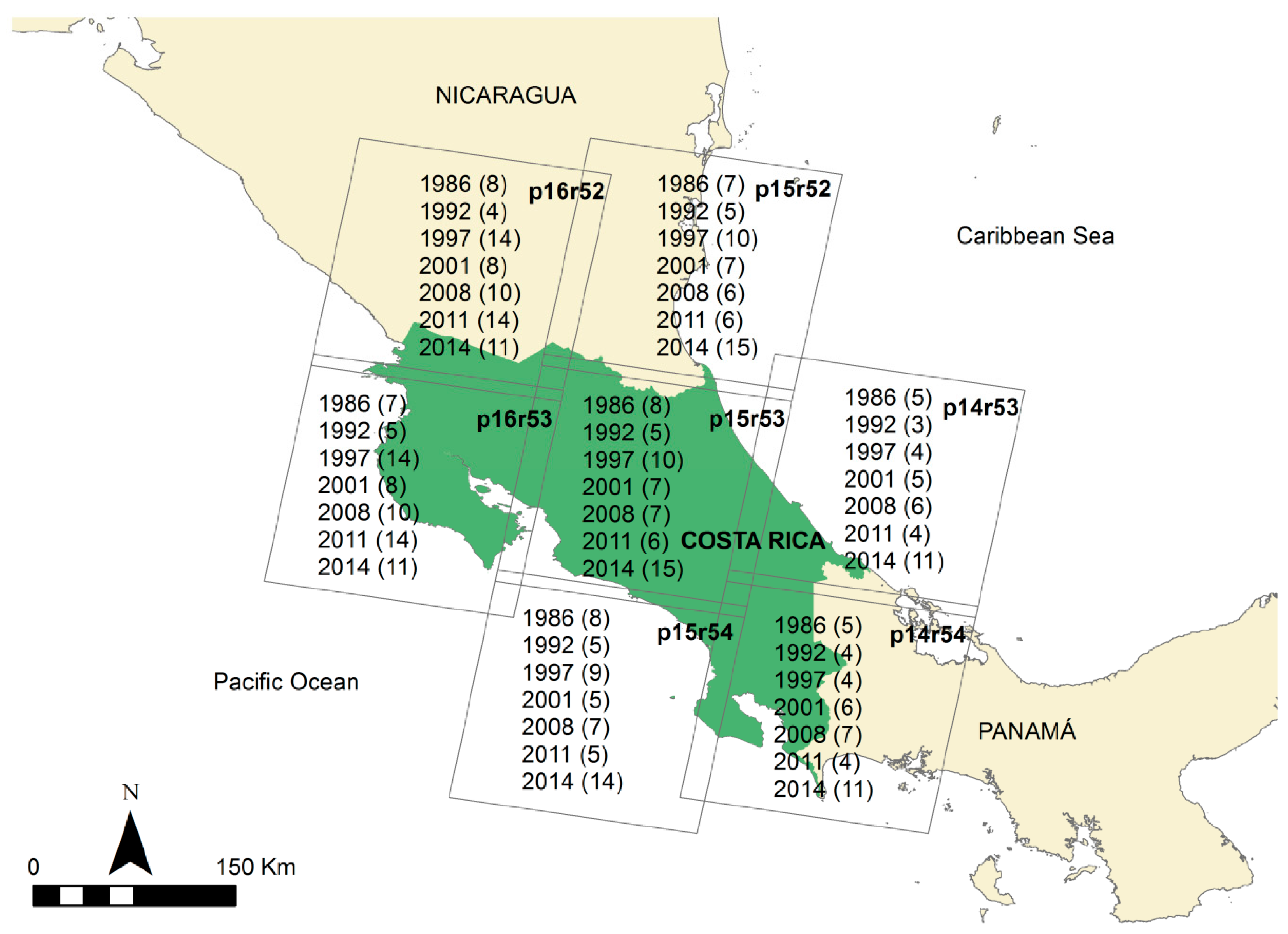
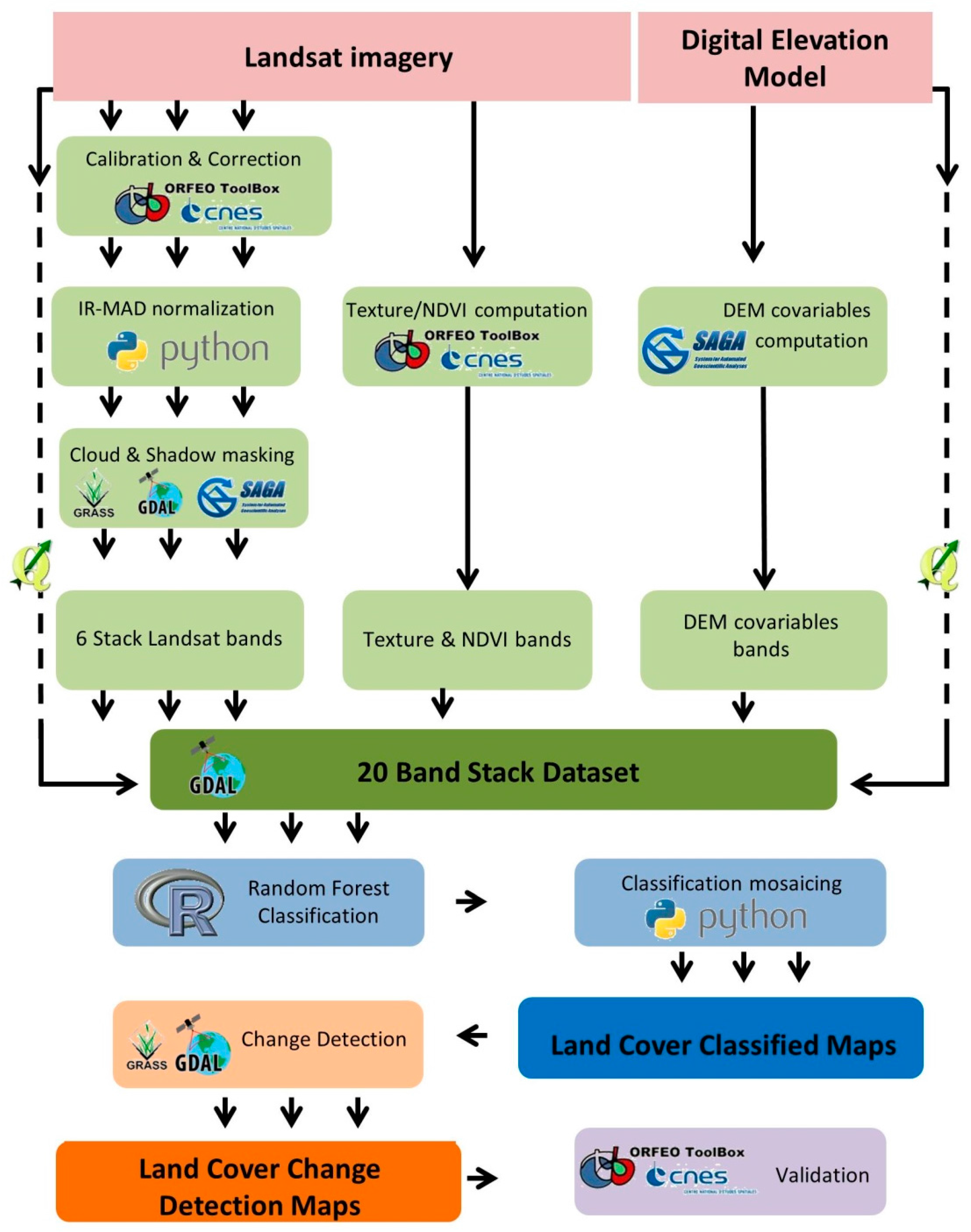
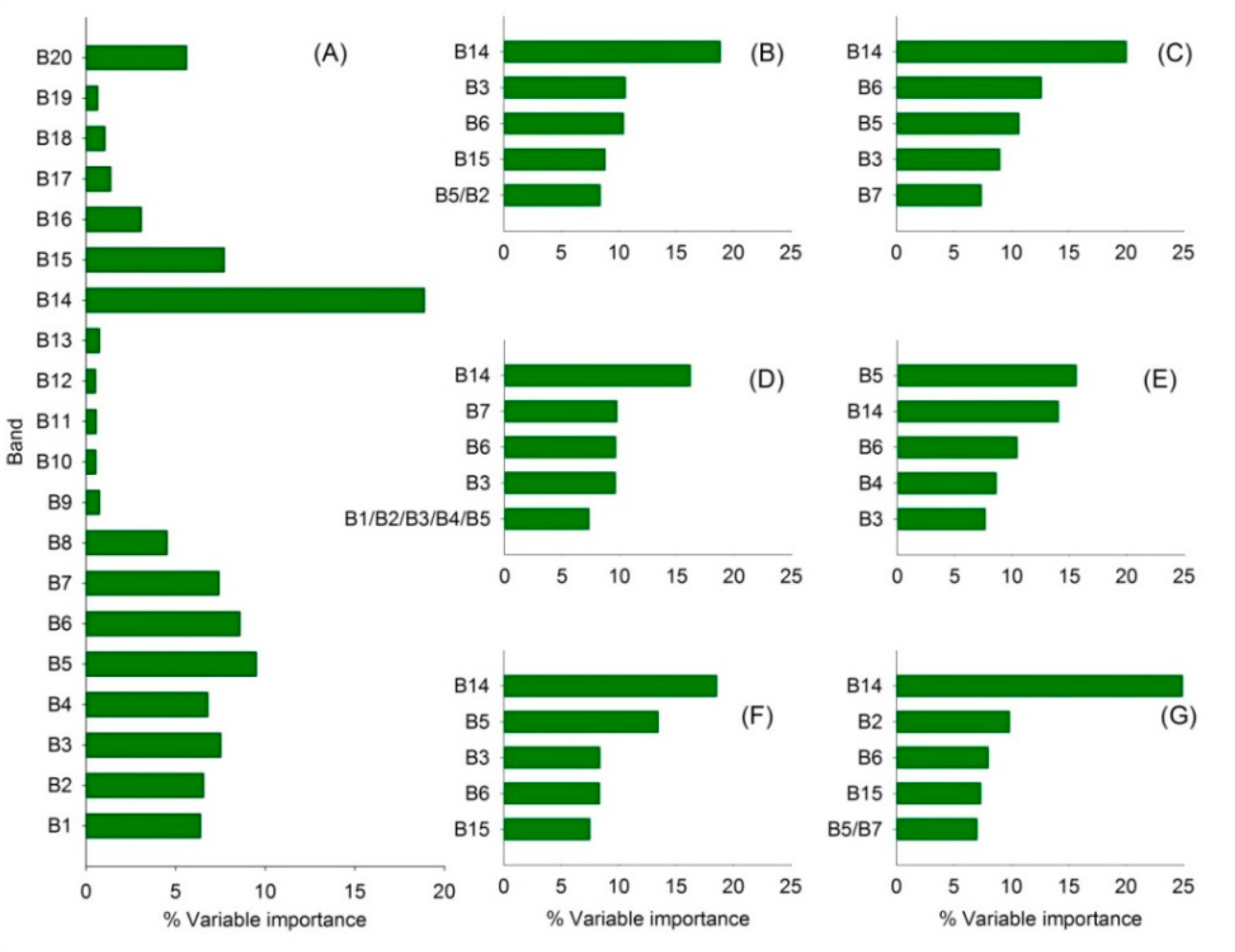

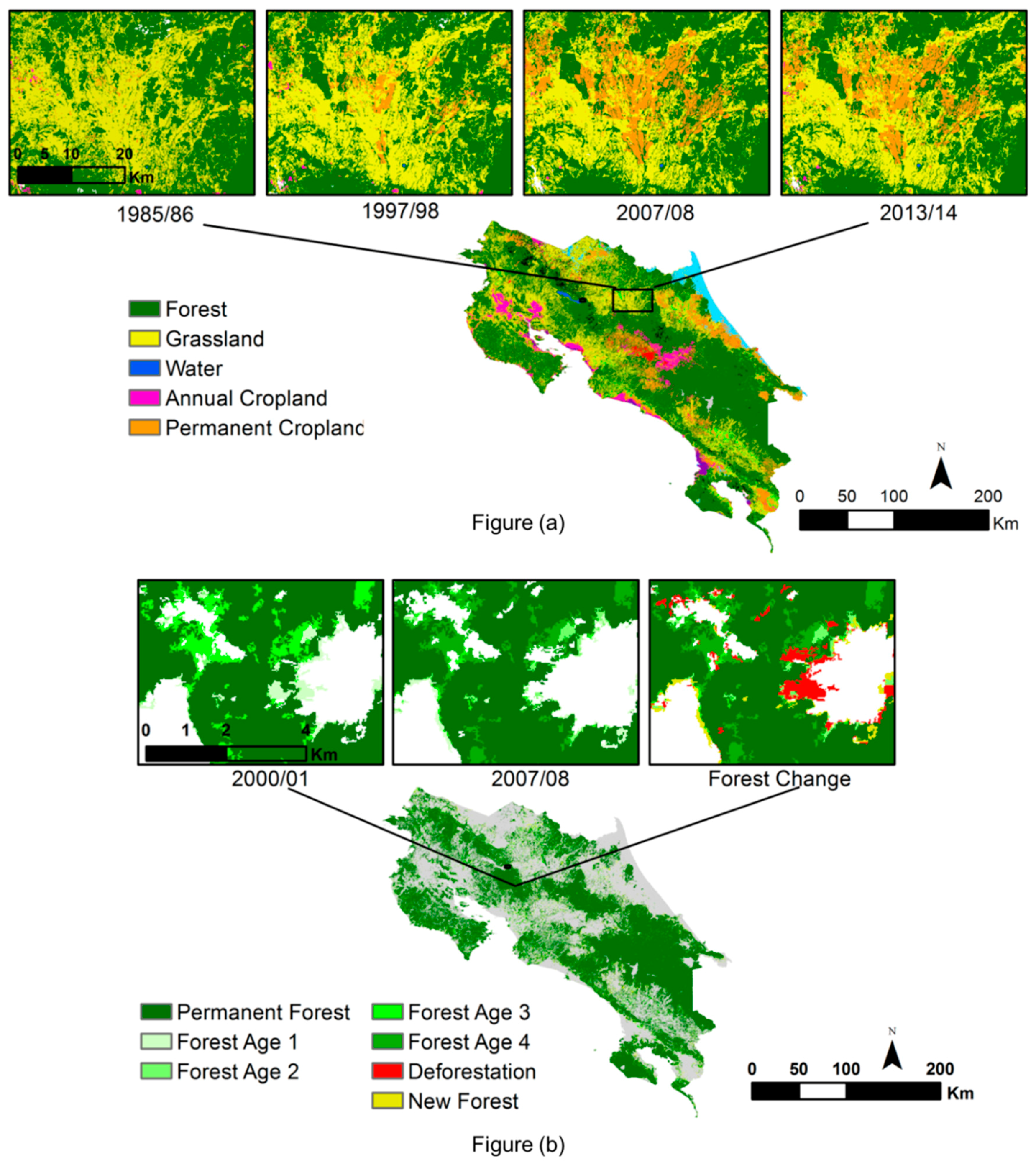
| IPCC 2006 Class | LC Costa Rica | LC Class Description |
|---|---|---|
| Forest | Forest | Including also planted forests |
| Mangrove | Waterlogged forest | |
| Palm forest | Waterlogged forest | |
| Settlement | Settlement | |
| Grassland | Grassland | Including anthropic pastures and natural grasslands mainly in waterlogged areas |
| Wetland | Water | Water bodies |
| Other land | Bare land | |
| Paramo | ||
| Cropland | Annual crops | Including rice, sugar cane and other annual crops |
| Pineapple | ||
| Coffee | ||
| Other permanent crops | Including oil palm, orange, mango and other permanent crops |
| Group of Variables | Band Number | Variable |
|---|---|---|
| Spectral | 1 | Blue |
| 2 | Green | |
| 3 | Red | |
| 4 | NIR | |
| 5 | SWIR-1 | |
| 6 | SWIR-2 | |
| Vegetation Index | 7 | Normalized Difference Vegetation Index (NDVI) |
| Texture Indices | 8 | Mean |
| 9 | Sum Entropy | |
| 10 | Difference of Entropies | |
| 11 | Difference of Variances | |
| 12 | IC1 | |
| 13 | IC2 | |
| Digital Elevation Model | 14 | Elevation |
| 15 | Slope | |
| 16 | Hillshade | |
| 17 | Plan curvature | |
| 18 | Profile curvature | |
| 19 | Convergence Index (CI) | |
| 20 | Multiresolution Index of Valley Bottom Flatness (MRVBF) |
| Validation Year | Overall Accuracy | Land Cover Class | Producer’s Accuracy | User’s Accuracy |
|---|---|---|---|---|
| 1985/1986 | 0.89 | Forest | 0.89 | 0.91 |
| No-forest | 0.88 | 0.85 | ||
| 2000/2001 | 0.93 | Forest | 0.92 | 0.94 |
| No-forest | 0.94 | 0.92 | ||
| 2013/2014 | 0.87 | Forest | 0.91 | 0.91 |
| Palm forest | 0.68 | 0.99 | ||
| Mangrove forest | 0.97 | 0.91 | ||
| Settlement | 0.99 | 0.92 | ||
| Grassland | 0.85 | 0.76 | ||
| Paramo | 0.94 | 0.85 | ||
| Water | 0.97 | 0.60 | ||
| Bare land | 0.19 | 0.58 | ||
| Annual crops | 0.81 | 0.88 | ||
| Pineapple | 0.88 | 0.93 | ||
| Other permanent crops (including coffee) | 0.82 | 0.93 |
| Change Classes | Description | Producer’s Accuracy (Omission) | User’s Accuracy (Commission) | Overall Accuracy |
|---|---|---|---|---|
| Deforestation | Forest to Non-Forest | 0.49 (0.36–0.62) | 0.62 (0.47–0.77) | 0.86 (0.83–0.89) |
| Afforestation/reforestation | Non-Forest to Forest | 0.50 (0.38–0.62) | 0.75 (0.62–0.88) | |
| Forest (no change) | Forest remaining Forest | 0.95 (0.93–0.97) | 0.88 (0.84–0.91) | |
| Non-forest (no change) | Non-Forest remaining Non-Forest | 0.84 (0.8–0.88) | 0.87 (0.83–0.92) |
| Forest Change Detection Period | 1991 | 1997 | 2000 | 2007 | 2011 | 2013 |
|---|---|---|---|---|---|---|
| 1986–1991 | 1–6 | 7–12 | 13–15 | 16–22 | 23–26 | 27–28 |
| 1992–1997 | 1–6 | 7–9 | 10–16 | 17–20 | 21–22 | |
| 1998–2000 | 1–3 | 4–10 | 11–14 | 15–16 | ||
| 2001–2007 | 1–7 | 8–11 | 12–13 | |||
| 2008–2011 | 1–4 | 5–6 | ||||
| 2012–2013 | 1–2 |
© 2016 by the authors; licensee MDPI, Basel, Switzerland. This article is an open access article distributed under the terms and conditions of the Creative Commons Attribution (CC-BY) license (http://creativecommons.org/licenses/by/4.0/).
Share and Cite
Fernández-Landa, A.; Algeet-Abarquero, N.; Fernández-Moya, J.; Guillén-Climent, M.L.; Pedroni, L.; García, F.; Espejo, A.; Villegas, J.F.; Marchamalo, M.; Bonatti, J.; et al. An Operational Framework for Land Cover Classification in the Context of REDD+ Mechanisms. A Case Study from Costa Rica. Remote Sens. 2016, 8, 593. https://doi.org/10.3390/rs8070593
Fernández-Landa A, Algeet-Abarquero N, Fernández-Moya J, Guillén-Climent ML, Pedroni L, García F, Espejo A, Villegas JF, Marchamalo M, Bonatti J, et al. An Operational Framework for Land Cover Classification in the Context of REDD+ Mechanisms. A Case Study from Costa Rica. Remote Sensing. 2016; 8(7):593. https://doi.org/10.3390/rs8070593
Chicago/Turabian StyleFernández-Landa, Alfredo, Nur Algeet-Abarquero, Jesús Fernández-Moya, María Luz Guillén-Climent, Lucio Pedroni, Felipe García, Andrés Espejo, Juan Felipe Villegas, Miguel Marchamalo, Javier Bonatti, and et al. 2016. "An Operational Framework for Land Cover Classification in the Context of REDD+ Mechanisms. A Case Study from Costa Rica" Remote Sensing 8, no. 7: 593. https://doi.org/10.3390/rs8070593
APA StyleFernández-Landa, A., Algeet-Abarquero, N., Fernández-Moya, J., Guillén-Climent, M. L., Pedroni, L., García, F., Espejo, A., Villegas, J. F., Marchamalo, M., Bonatti, J., Escamochero, I., Rodríguez-Noriega, P., Papageorgiou, S., & Fernandes, E. (2016). An Operational Framework for Land Cover Classification in the Context of REDD+ Mechanisms. A Case Study from Costa Rica. Remote Sensing, 8(7), 593. https://doi.org/10.3390/rs8070593





